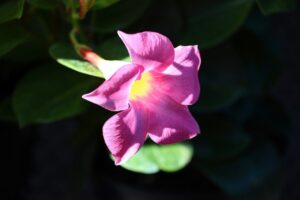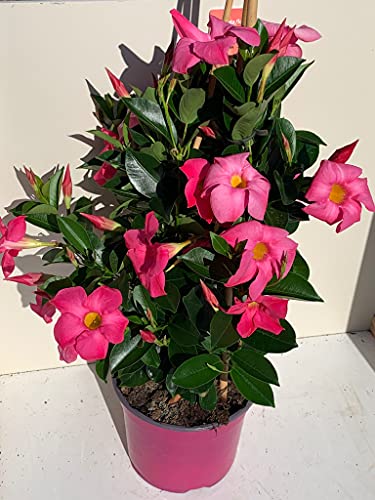Prune Dipladenias: [Importance, Time, Tools, Considerations and Steps]

 For flower lovers, dipladenia can be a great option as it reproduces a beautiful, vibrantly colored flower.
For flower lovers, dipladenia can be a great option as it reproduces a beautiful, vibrantly colored flower.
Pruning is one of the care that needs to be implemented to keep it in perfect size and to ensure that it distributes its nutrients well.
It is a fairly simple task that can be performed by anyone, even if they are not an expert gardener. But if you do not feel very sure of what you have to do, here we will give you the guidelines so that you can carry out this mission without setbacks.
Why prune dipladenias?
The reasons that can lead you to prune a dipladenia are very varied and include:

- Clean the plant of all those parts that are in poor condition, either because they have fulfilled their objective or because they are sick.
- Allow the nutrients to be distributed in a more balanced and concentrated way, which stimulates the progressive growth of the plant and helps its flowering have better characteristics.
- Rinse the inner part of the bush so that light and air penetrate more easily. This, in turn, contributes to its good health.
When is it better to carry out dipladenia pruning?
 It is best to apply the pruning when the plant is in vegetative recess but it is not long before it begins its internal activity.
It is best to apply the pruning when the plant is in vegetative recess but it is not long before it begins its internal activity.
This time corresponds to the end of winter or the first days of spring , anticipating that there are no risks of frost.
In this way, you will be offering safety to the plant and will help it to recover from the wounds in a short time. This does not imply that if at a certain moment in another era there is a need to withdraw some part, it cannot be done.
Applies in case of wilted or diseased areas that it is advisable to remove as soon as they are noticed. Similarly, when hickeys are born.
What tools should we use to prune dipladenias?
Dipladenias can be pruned with normal-sized garden shears because their stems are usually not very thick.

These must be well disinfected, preferably with alcohol, and sharpened so that the cuts are precise and clean.

What considerations should we take into account when pruning dipladenias?
The pruning of dipladenias can be of three types: maintenance, flowering and rejuvenation. Therefore, the first step will be to decide what type of pruning you are going to carry out in order to be clear about the points on which you will focus.

It is also essential to prepare in advance the tools and the space where you will leave the waste to work in order.
How to prune dipladenias without damaging the plant?
Dipladenias can be subjected to different types of pruning depending on the objective you are pursuing.
Maintenance pruning
 It is the pruning that is carried out more frequently and that can occupy the whole year, since the idea is to eliminate the parts that have no function within the plant .
It is the pruning that is carried out more frequently and that can occupy the whole year, since the idea is to eliminate the parts that have no function within the plant .
Here it will be necessary to remove all the parts that are withered or diseased. They are easy to recognize because they do not have a bright green color.
It also includes flowers that have already given their life span and that tend to wither later. Pacifiers are another part that should be removed because they tend to consume energy without providing a good structure.
Its location is between a stem and a bud. Ideally, the cut should be made precisely close to the stem, without damaging it, using an oblique direction. Finally, you have to attend to the sprouts that generally appear at the base of the plant , near the root.
Flowering pruning
 It is the pruning that is carried out annually, preferably in spring, and that aims to improve the general flowering of the plant.
It is the pruning that is carried out annually, preferably in spring, and that aims to improve the general flowering of the plant.
The idea here is to renew the general conditions of the dipladenia so that it is able to produce new and beautiful flowers.
The first thing is to remove all the shoots that have already flowered in the past period . Their lifespan is over and they will not flourish again.
If there are light or ventilation problems due to excess branches, it will be worth clarifying a bit to ensure a good flow of both elements. Due to the characteristics of this pruning, it is possible to apply it in conjunction with maintenance.
Rejuvenation pruning
 It is a pruning that is carried out in order for the plant to experience new growth of its productive parts and not lose its flowering capacity .
It is a pruning that is carried out in order for the plant to experience new growth of its productive parts and not lose its flowering capacity .
For this, the dipladenia is subjected to a very intense pruning where at least 50% of its structure will be removed. It is important that the plant is in perfect health so that it is able to resist it.
Otherwise, you will die without a doubt. In addition, it will be convenient to help her with the incorporation of subscribers and good environmental conditions. The pruning of dipladenia is a simple action to carry out and that, in return, will offer us very good results, so do not stop applying it.



![Photo of How to germinate Palm Tree Seeds: [Time, Steps and Planting]](https://www.complete-gardening.com/wp-content/uploads/2022/08/how-to-germinate-palm-tree-seeds-time-steps-and-planting-390x220.jpg)
![Photo of Red Maple: [Crop, Associations, Pests and Diseases]](https://www.complete-gardening.com/wp-content/uploads/2022/08/red-maple-crop-associations-pests-and-diseases-390x220.jpg)
